
Thousand Canker Disease Control in Fort Collins
What is thousand cankers disease?
Thousand cankers disease is caused by walnut twig beetles tunneling into the bark of the black walnut tree, spreading the Geosmithia morbida fungus. The fungus creates cankers that destroy the inner bark interrupting transport of water and nutrients. Large numbers of cankers can girdle a branch or the tree trunk, killing the branch or tree.
Thousand cankers disease attacks walnut trees and wingnuts, and the black walnut is very susceptible to attack which is usually fatal. A decline in the black walnut tree population in Colorado was noticed in 2001, the first walnut twig beetle was discovered in Colorado in 2004, and all black walnut trees in Colorado Springs were dead by 2008. Most of the black walnut trees in areas where the walnut twig beetle is found will die from thousand cankers disease.
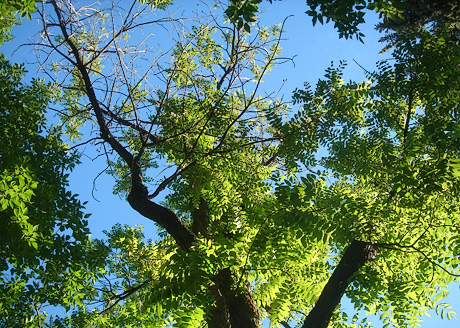 Curtis Utley, CSUE, Bugwood.org
Curtis Utley, CSUE, Bugwood.org
How to identify thousand cankers disease
The first symptoms of thousand cankers disease are yellowing and thinning of upper branches and dead branches, many small 1/32" diameter holes in the bark, and many small cankers in the inner bark. The presence of many small dark cankers and beetle tunnels in black walnut is almost always due to thousand cankers disease. Trees usually die within 3-4 years after the first symptoms are noticed.
The adult walnut twig beetle is about 1/16" long and 1/32" wide, and yellowish brown in color. The larvae are white, c-shaped grubs found in the phloem of the trunk and limbs larger than 2cm diameter of black walnut trees.
Thousand cankers disease causes 2 types of cankers, branch cankers and diffuse cankers, neither type is very noticeable until the bark is removed, but they may stain the bark a dark amber or brown color. The branch cankers are small (up to about 1 1/4" across), diffuse, and dark brown to black. They grow around the beetle tunnels and occur in enormous numbers, hence the name "Thousand Cankers Disease". The diffuse cankers can be much larger, often longer than 6'. They cause the inner bark and cambium to be water soaked and stained dark brown to black, and are found in dying black walnut trees.
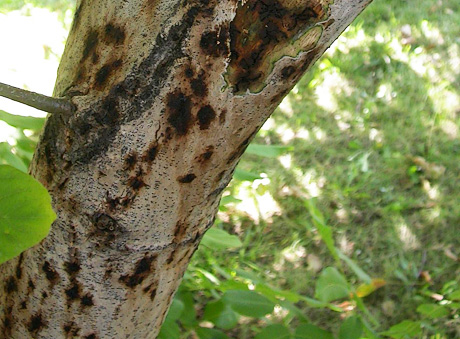 Ned Tisserat, Colorado State University, Bugwood.org
Ned Tisserat, Colorado State University, Bugwood.org
Life cycle of thousand cankers disease
The walnut twig beetles overwinter as larvae and adults in galleries excavated in the bark. The adults become active in late April, and some leave the tree while others remain in the same tree. The males find a suitable black walnut tree, excavate a mating chamber under the bark, and release pheromones to attract females. After mating, the females lay eggs in tunnels in the inner bark. The larvae feed for 4-6 weeks after hatching, then they pupate. Adult walnut twig beetles emerge from their pupas and search for mates in the early summer. The walnut twig beetle can have a new generation every 6-7 weeks during the summer, usually 2-3 generations per year. The mating continues until early fall, when the adults and larvae prepare to overwinter in their tunnels.
They adults carry the Geosmithia morbida fungus on their bodies, infecting new locations in the same tree and new trees. The fungus can grow to about 1 1/4" in less than a month.
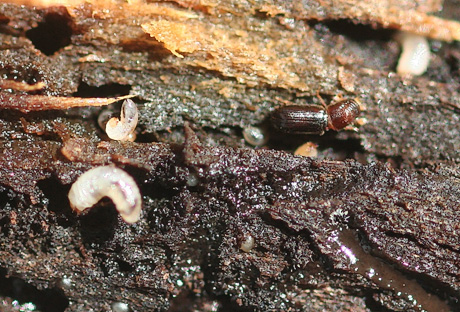 Whitney Cranshaw, Colorado State University, Bugwood.org
Whitney Cranshaw, Colorado State University, Bugwood.org
How to control thousand cankers disease
Don't plant black walnut trees in areas affected by the thousand canker disease. Destroy infected trees before they can infect healthy trees. Do not move the materials from infected trees to areas not already infected as you may spread the disease.
Spraying insecticides to kill the walnut twig beetles is not very effective because you have to spray the beetles when they are outside their tunnels, which can be anytime from late April to early fall. Systemic insecticides are less effective because the fungus damages the inner bark, blocking the insecticide from getting to the beetles.
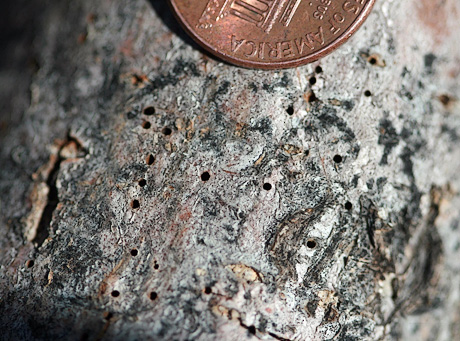 Whitney Cranshaw, Colorado State University, Bugwood.org
Whitney Cranshaw, Colorado State University, Bugwood.org
Other resources
- CSU Pest Alert: Walnut Twig Beetle and Thousand Cankers Disease of Black Walnut
- CSU: Diagnosing Thousand Cankers Disease of Walnut
- Q&A about Thousand Cankers Disease of Walnut
- Thousand Cankers Disease
- USDA Forest Service: Thousand Cankers Disease
- USFS Special Projects: Thousand Cankers Disease
- UC IPM: Thousand Cankers Disease and the Walnut Twig Beetle in California
- Bugwood Presents: Thousand Cankers Disease of Walnut
- Wikipedia: Thousand cankers disease
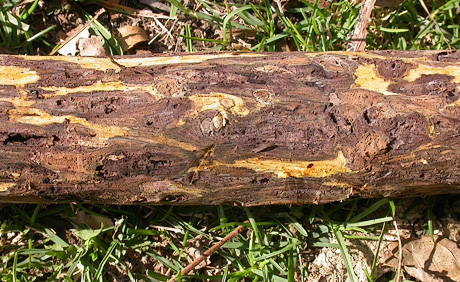 Ned Tisserat, Colorado State University, Bugwood.org
Ned Tisserat, Colorado State University, Bugwood.org





